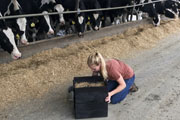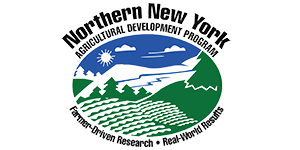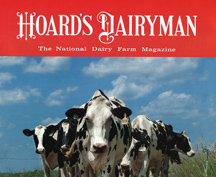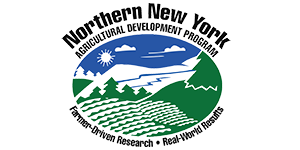
June 3, 2022. The results of Northern New York Agricultural Development Program (NNYADP)-commissioned research in 2021 provide farm-based data on the importance of proper feeding management for dairy cows during the pre-calving to post-calving period. This NNYADP project was one of the first to apply the Metabolic Health Index adapted by the Overton Lab at Cornell University to identify cows that may be at higher risk of post-calving health issues. The 18-page “Evaluating Transition Cow Health on NNY Dairy Farms and Associations with Feeding Management Practices” report is posted under Research: Dairy at https://nnyagdev.org/wp-content/uploads/2022/02/NNYADP2021TransitionCowReport24FINAL.pdf .
“This research provided the opportunity to make a preliminary evaluation of the relationships among different metabolic health parameters of dairy cows through the pre-calving to post-calving transition period,” said project leader Casey Havekes, a Cornell Cooperative Extension North Country Ag Team dairy specialist, based in Canton, New York.
A broad range of data from 10 farms in 2021 revealed opportunities to improve pre-calving feeding management and, to a lesser extent, post-calving feeding programs.
“This first trial has identified areas to explore different feeding management strategies for the purpose of positively impacting transition cow health and post-calving performance and success,” said Havekes.
This research establishes a foundation to begin developing a statistically-accurate tool that dairy farmers and farm consultants can use to track the impact of transition cow feeding management programs and adjustments of those programs.
Specific areas identified for attention on the participating farms include particle size in the feed ration and properly mixing a ration specifically for cows in the transition period to encourage optimal nutrition during a time of increased nutrient demand to support the onset of calving and milk production.
Havekes is now analyzing reproduction and post-calving milk production data and working with the participating farms to develop farm-specific feeding programs to meet each farm’s needs.
Cornell PRO-DAIRY Director Thomas Overton, Ph.D., who partnered with Havekes to develop the research plan, noted, “Prior to this Northern New York Agricultural Development Program project, there had been little to no research done at scale on the impact of feeding management in the dry cow diet on cow health through the transition period.”
Dr. Trevor DeVries, a University of Guelph professor and Canada Research Chair in Dairy Cattle Behavior and Welfare, Guelph, Ontario, Canada; and Dr. Allison Kerwin, dairy field research specialist, Cornell University, Ithaca, New York, were project collaborators.
 The Northern New York Agricultural Development Program is a farmer-driven research program, established by the New York State Legislature for the six northernmost counties of New York State. Funding for the Program is supported through the New York State Assembly and administrated by the New York State Department of Agriculture and Markets.
The Northern New York Agricultural Development Program is a farmer-driven research program, established by the New York State Legislature for the six northernmost counties of New York State. Funding for the Program is supported through the New York State Assembly and administrated by the New York State Department of Agriculture and Markets.
 Hoard’s Dairyman, The National Dairy Farm Magazine, has made note of two NNYADP projects: its May 2022 includes a just-inside-the-front-cover article by Paul Virkler, D.V.M., and Wolfgang Heuwieser, D.V.M., titled “E-Training proves the need for refresher courses,” on the pilot project funded by the NNYADP that developed five dairy training modules that farm employees can access on their smartphones or laptops. This project was tested as an alternative to face-to-face education during the pandemic with positive results. The May 19, 2022 Hoard’s Dairyman E-News include noted of the NNYADP’s 2022 dairy project that is evaluating kefir as a probiotic supplement for dairy calves.
Hoard’s Dairyman, The National Dairy Farm Magazine, has made note of two NNYADP projects: its May 2022 includes a just-inside-the-front-cover article by Paul Virkler, D.V.M., and Wolfgang Heuwieser, D.V.M., titled “E-Training proves the need for refresher courses,” on the pilot project funded by the NNYADP that developed five dairy training modules that farm employees can access on their smartphones or laptops. This project was tested as an alternative to face-to-face education during the pandemic with positive results. The May 19, 2022 Hoard’s Dairyman E-News include noted of the NNYADP’s 2022 dairy project that is evaluating kefir as a probiotic supplement for dairy calves. Learn more about NNYADP dairy research under the Research: Dairy tab on this website.
Learn more about NNYADP dairy research under the Research: Dairy tab on this website.

 The State funding supports the NNYADP’s tile drainage and water quality-focused agricultural environmental stewardship research that is producing progressive real-world, data-based results sought out by entities statewide and nationally.
The State funding supports the NNYADP’s tile drainage and water quality-focused agricultural environmental stewardship research that is producing progressive real-world, data-based results sought out by entities statewide and nationally. Additionally, researchers with an NNYADP grant are investigating the use of kefir as a probiotic supplement to enhance the health of dairy calves.
Additionally, researchers with an NNYADP grant are investigating the use of kefir as a probiotic supplement to enhance the health of dairy calves.
